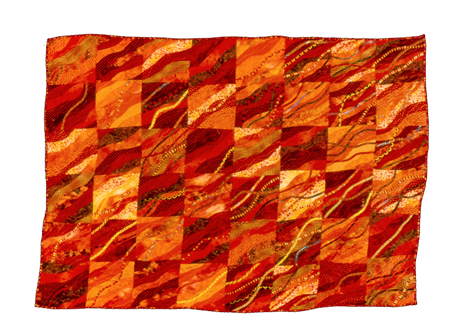A member of the QuiltArt list this morning referred to ‘Scott Murkin’s technique’, and I thought “Hmmm, I wonder what that is….” (As I don’t get the popular quilt magazines and books these days, its easy to be out of touch with the very latest) Anyway, it turned out to be freehand or improvisational piecing, anyway! And when I went online to find out about Scott’s work I found this site, http://www.scottmurkin.com , and there is a quilt

that looked to me very like an adaptation and re-arrangement of blocks from one of my own bushfire quilts . They have a great deal in common, I’m sure you’ll agree, but I’m not suggesting that this is in anyway ‘copying’ something I did ages ago:

Bushfire 4 1999
I think it is inevitable that quilt makers using the same techniques in similar colours, will sometimes produce similar looking works. We can usually tell looking at someone’s work who they studied with, since, for a while after that workshop their new work reflects what they have learned, but in time their work reflects more of the artist and increasingly less of the teacher. It’s why I myself no longer attend technique-driven workshops, but they are the bread and butter of the quilt making industry, of course.
“Scott Murkin’s” technique is what I and many others learned nearly 25 years ago from Nancy Crow – not that I ever called it ‘Nancy Crow’s technique’ because for her, technique has only ever been the means to her end – in the classroom it was to speed the process of exploring colour and design, and working through her long list of class exercises was only really possible via cutting and piecing freehand/improvisationally.
But actually, it wasn’t her technique, either. It was developed by a Canadian quiltmaker, Marilyn Stothers who Nancy used to take into the classes she was teaching at Houston in the late 80’s and early 90’s and have Marilyn show her students how to do it. Nancy then began teaching it herself as a method useful in her classes on colour and design. As we all know, today there are many contemporary quilt makers working this way all over the world, and it has become a contemporary quilt making tradition, if you can say such a thing…. and yes, I think we can.
Since learning the basics, I’ve always worked this way, and taught many students how to cut and piece freehand. I’ve no doubt someone uses “Alison Schwabe’s technique” to describe their own improvisational piecing, but I claim no ownership. If you’d like to have a go at it, email me for the basic instructions (2 pages incl, diagrams and links) and I’ll email it by return. There’s enormous interest in piecing like this.
Last month I taught my “Hot Quilts From Cold Scraps” workshop in Dongara Western Australia, and Hobart Tamsnaia Aus. I always promote the class as being about planning and making successful scrap quilts, and one in which people who work via traditional geometric piecing will be alongside those who are piecing improvisationally. In other words, how you piece is up to you, and you just need to come to class knowing how to piece one way or the other, it’s not a beginners’ class. I always say I don’t actually teach freehand piecing in class, as there isn’t usually time even in the 2-day version, and so if you want to work that way you need to learn the basics at home before the workshop. That usually works well, and one or two people always ask me for those instructions in advance. In Dongara there were about 20 enthusiasts in the class – fabulous facilities accommodated them easily – and about 1/3 went to work piecing traditionally, the rest improvisationally. They produced some wonderful work, and everyone achieved plenty of it. The class in Hobart blew me away though. I had been a bit concerned at the low number registered, and anticipated the group dynamics might be a bit unexciting among only 7 of them. But not in this case – all had very strong individual approaches and a couple did interesting things no one has previously produced, including myself! Some already knew improvisational piecing, and the 2 or 3 who didn’t clearly did want to work that way. So once everyone was into their exercises before branching off in their individual directions, in such a small group it was easy to teach them the basic methods by demonstrations using the samples I had with me. They were all dead keen and very quick on the uptake.
Thanks to Pat and Susan who both supplied Marilyn’s correct surname which I’d used wrongly in the first version of this post! I have corrected and edited the post to include the gracious corrections I received from Marylin herself, whose website http://www.marilynstewartstothers.ca/ presents her and her exciting work in some detail – and I can only say after looking at it that we don’t hear enough of her.









